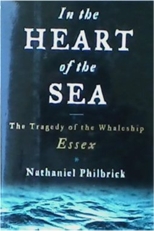There once was a whaleship from Nantucket
by Phyllis Wright
 Many don’t realize that in early 1800s America, commercial whaling was a multimillion-dollar business. Millions of gallons of whale oil were used in America and Europe for lamp fuel and lubrication, in addition to dozens of other uses: It was a fundamental element of paint, varnish, and soap. Perhaps the main center of the whaling industry in North America was Nantucket, a small island off the coast of Massachusetts inhabited mainly by Quakers.
Many don’t realize that in early 1800s America, commercial whaling was a multimillion-dollar business. Millions of gallons of whale oil were used in America and Europe for lamp fuel and lubrication, in addition to dozens of other uses: It was a fundamental element of paint, varnish, and soap. Perhaps the main center of the whaling industry in North America was Nantucket, a small island off the coast of Massachusetts inhabited mainly by Quakers.
A fascinating, sensational, and true story of men from Nantucket, In the Heart of the Sea covers the tragic voyage of the whaleship, Essex. The ship sailed around Cape Horn into the South Pacific—that distant ocean was where the vast amount of whaling occurred (wholly astonishing to me and to most people I’ve talked to)—, then was rammed and capsized by an giant sperm whale. The subsequent survival story on the open sea and on a small sliver of island, from which eight men were eventually rescued, ranks as one of the most remarkable adventure stories of all time. The capsizing occurred on November 20, 1821.
Elements of the story of the Essex were used by Herman Melville in his classic Moby Dick (1851); Melville had actual experience crewing on Nantucket whalers. Author Philbrick does a fine job giving us the background of life in Nantucket, as well as the rigors and dangers of whaling work—often vessels would be away from home for up to three years. Then of course he writes a likely drama of the Essex based on documents and statements of the survivors.
The story of the capsizing of the Essex was leading news in New England and New York of the 1820s, just as the story of the sinking of the Titanic was to the world 90 years later. As other well-known ordeals of people going without food for long periods—such as the Donner Party in the American West (1846, 47) or more recently the Uruguayan rugby team that crashed in the Andes (1972)—survival of the men of the Essex needed some resort to cannibalism.
The author shows deep insight into the mores of the time, and understands how men accepted authority and handled adversity. Almost to a man, they show astounding courage and resourcefulness. Philbrick captures the feeling of being a crew member or an officer on board one of the three 25-ft. chalupas, used as lifeboats following the capsizing.
The whale upended the vessel in the Pacific Ocean at the equator approximately 2000 miles west of the Galapagos Islands—another virtue of the book is its clear and several maps. The men salvaged a smattering of food and water and fitted each of the lifeboats with a manner of sail. Stores were small and navigation nearly impossible; the initial goal to head east toward South America was thwarted because they could only manage a southward tack at the beginning.
Many argue that the captain made a couple of bad decisions.
Approximately 90 days after the floundering of the Essex, the eight men, including the captain and first mate, were rescued by other whaling vessels near the western coast of South America. The men were emaciated and close to death. Philbrick discusses the process of starvation and dehydration, as a scientist, citing studies that give the reader a scary feel for what the victims endured.
Finally, the author, covers the aftermath of the catastrophe, back in Nantucket. What directions in life the survivors would take, career moves, marriages, and so on. You will feel part of their culture, as if it were still alive; you learn an awful lot about whaling as way of life. For instance:
Just think about throwing a harpoon from the bow of a 25-ft. boat into the 15-ft.-long head of a 70-ft-long, 60-ton creature moving at 5-10 knots in the open sea, then making sure the harpoon sticks, and wearing out the whale until it subsides, finally killing it with lances. No wimps! [Of course, not too many people in that era think about how the whale feels about all this mayhem.]
Toward that end, from the perspective of the whale as it were, consider the following factual information by Philbrick:
“It is estimated that the Nantucketers and their Yankee whale-killing brethren harvested more than 225,000 sperm whales between 1804 and 1876. In 1837, the best year in the century for killing whales, 6,767 were taken. (As a disturbing point of comparison, in 1964, the peak year of modern whaling, 29,255 sperm whales were killed.) Some researchers believe that by the 1860s whalemen may have reduced the world’s sperm whale population by as much as 75%; others claim it was diminished by only 8% to 18%. Whatever figure is closer to the truth, sperm whales have done better than other large cetaceans hunted by man. Today there are between one and a half to two million sperm whales, making them the most abundant of the world’s whales.”
Great tale of adventure and endurance. Philbrick has a deft touch that brings you into the action as both an expert observer and one of the actors.
This post has been read 1876 times!


